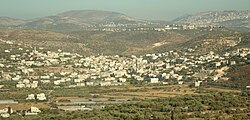User:Asad112/sandbox/Anabta
Anabta | |
|---|---|
| Arabic transcription(s) | |
| • Arabic | عنبتا |
| • Latin | 'Anabta (official) 'Anabta and Iktaba (unofficial) |
 View of Anabta from the nearby town of Bal'a | |
Location of Anabta within Palestine | |
| Coordinates: 32°18′25.80″N 35°07′01.00″E / 32.3071667°N 35.1169444°E | |
| State | State of Palestine |
| Governorate | tk |
| Government | |
| • Type | Municipality |
| • Head of Municipality | Yasser Barakat |
| Population (2009) | |
| • Total | 8,300 |
Anabta (Arabic: عنبتا) is a Palestinian town in the Tulkarm Governorate in the northern West Bank, located 9 kilometers east of Tulkarm. According to the Palestinian Central Bureau of Statistics, Anabta had a population of 7,300 inhabitants in 2006.[1] The town has an urban area of about 1,300 dunams. Most of its exterior lands are planted with olives, figs and almonds or covered by forests. Water is provided by five underground wells, with distribution supervised by the town's municipality.[2]
The number of inhabitants in Anabta in 1922 was about 1,606 people — which rose to about 3,120 people in 1945, while the number of inhabitants in 1967 after its occupation by Israel was about 3,400. By 1987, there were 5,700 residents in Anabta. In 2009, there were 8,300 residents in Anabta.[2]
Meaning[edit]
Anabta is a two-part word consisting of "Anab" (Arabic for grape) and "Ta," a word referencing a Roman village. The name as evidenced by the large number of grape presses hewn in the rocks of the hills surrounding the city.[3]
History[edit]
Some of olive trees still existing in Anabta are said to date back to the time of Roman Empire. During the reign of Sultan Baibars al-Bunduqdari in the 13th century, Anabta was used as a center point to supply the Muslim armies warring against the Crusaders and the Mongols. The location was chosen because it was considered relatively easy to protest as the area is nestled between two large hills. In 1936, two Jewish drivers were shot and killed on the Nablus-Tulkarm road in an area just west of Anabta. This event is largely credited to being the first event in the largely unsuccessful 1936-1939 Arab revolt in Palestine.[4] A now removed portion of the Hejaz Railway ran through the middle of the town parallel to the main street.[5]
Geography[edit]
Location[edit]
Anabta is located 19 kilomeeters west of Nablus and 9 kilometers east of Tulkarm. The town is bordered to the north by the village of Kafr Rumman, the south by the town of Kafr al-Labad, the east by the village of Ramin and the northwest by the town of Bal'a. The city is elevated 150 meters above sea level.[6][7]
Geographical nature[edit]
Anabta is surrounded by hills on all sides with a small valley that runs through the center of the town. [8]
Municipal[edit]
The Anabta Muncipality is one of the oldest in the Tulkarm Governorate. The first local council was established in 1923 and was promoted to a municipal council in 1954.[9]
Education[edit]
The town has two high schools and four elementary schools that are maintained and funded by the Palestinian Authority Ministry of Education.[10]
Effects of occupation[edit]
Anabta rests on the edge of area A of the Tulkarm area, which means the city is under full security and civil jurisdiction of the Palestinian Authority. The Israeli settlement Einav is situated to the southeast of the city and an Israeli checkpoint is positioned on the eastern entrance of the town which effectively controls the resident's access to the rest of the northern West Bank.[11]
Families[edit]
Residents of Anabta are typically divided among two large umbrella families, 'Amr and Al-Jetawi. These families are then divided twice into smaller families.[12]
| 'Amr | Al-Jetawi |
|---|---|
| 'Amr: 'Amr, Jadallah, Thwabi, Shehab, Kan'an, Subhi, 'Awad, Harash, Shehadi, Jaber | Sharaqa: Nour, Najjar, Abo-'asal, Shahadi, Bdran, Abo-as'ad, Qabshawi, Abo-kamli, Al-toom |
| Barakat: Barakat, Abo-'Aoun, Sdla, 'Adas, Belbesi, Ash-shaeb, Abo-shash, Sabah, Salami, Abo-Jamus, Al-farkh | Ism'ael: Ism'ael, Hamdallah, Qablawi, Hudali, Belbesi, Abo-'alia, Y'aqub, Nasar, Al-Asmar |
| 'Abd-daiem: 'Abd-daiem, Hejaz, Mar'ie, Hanoun, Makhlouf, Qaras, Kan'an, Zaq, S'ada, 'Abeed, Abo-'asha, Sawan, Taha | Qubbaj: Qubbaj, Sha'ar, Fayyad, Nasrallah |
| Melhem: Melhem, Sus, Sbeitan, Mwaswasi, Razaq | Mezeid: Mezeid, Ziad, 'Awad, Salami, Alhalu, Khdaer, Shahadi, Hamed, 'Akka, Qar'ai |
| Fuq'ha: Fuq'ha, 'Absa, A'araj, Razaq, 'Abd-samad, Sanjaq, Belbesi | |
| Nasar: Nasar, Sabubi, 'Awartani, Barqawi, Abo-raya, Zarbul |
Anabta also contains a significant population of Palestinians from Gaza who are not classified among the families.
Notable residents[edit]
Rami Hamdallah - President of An-Najah National University Mohammed Sabbah - WoLF
External links[edit]
Anabta Munciaplity
Anabta & Iktaba - Palestine Remembered Entry
References[edit]
- ^ Projected Mid -Year Population for Tulkarm Governorate by Locality 2004- 2006 Palestinian Central Bureau of Statistics
- ^ a b The city of Tulkarem and its villages Palestine Information Centre.
- ^ Anabta Anabta Muncipality entry titled "عنبتا" (Arabic)
- ^ 'Nablus Banidits Seen as Izz ed Din's followers', Palestine Post, Friday, 17 April 1936.
- ^ Anabta Anabta Muncipality entry titled "عنبتا" (Arabic)
- ^ Anabta Anabta Muncipality entry titled "عنبتا" (Arabic)
- ^ Tulkarem: town listing in a snapshot Palestine Remembered
- ^ Anabta Anabta Muncipality entry titled "عنبتا" (Arabic)
- ^ Anabta Anabta Muncipality entry titled "عنبتا" (Arabic)
- ^ Anabta Anabta Muncipality entry titled "عنبتا" (Arabic)
- ^ Map of the Separation Barrier in the West Bank B'Tselem
- ^ [1] Anabta Family Tree


